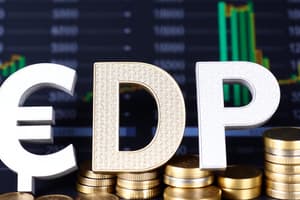Podcast
Questions and Answers
What is the focus of macroeconomics?
What is the focus of macroeconomics?
- Interactions of households and firms in markets
- The study of individual households and firms
- The economy as a whole (correct)
- How individual households and firms make decisions
What does Gross Domestic Product (GDP) measure?
What does Gross Domestic Product (GDP) measure?
- Both total income and total expenditure (correct)
- Total savings in the economy
- Total expenditure on the economy’s output of goods and services
- Total income of everyone in the economy
How does GDP relate to a nation’s income and spending?
How does GDP relate to a nation’s income and spending?
- GDP measures spending but not income
- GDP measures income but not spending
- GDP is related to both income and spending (correct)
- GDP is unrelated to both income and spending
What type of economics studies the actions of individual households and firms?
What type of economics studies the actions of individual households and firms?
What major event led to a rethinking of macroeconomics?
What major event led to a rethinking of macroeconomics?
For the economy as a whole, what is the relationship between income and expenditure?
For the economy as a whole, what is the relationship between income and expenditure?
What does GDP measure according to the circular-flow diagram?
What does GDP measure according to the circular-flow diagram?
What do households do in the circular-flow diagram?
What do households do in the circular-flow diagram?
What type of goods does GDP include according to the text?
What type of goods does GDP include according to the text?
What is GDP according to the text?
What is GDP according to the text?
What could be added to a more complicated circular-flow diagram according to the text?
What could be added to a more complicated circular-flow diagram according to the text?
What does GDP measure simultaneously according to the text?
What does GDP measure simultaneously according to the text?
Which sector trades goods, services, financial assets, and currencies with the country’s residents according to the text?
Which sector trades goods, services, financial assets, and currencies with the country’s residents according to the text?
What are factor payments according to the circular-flow diagram?
What are factor payments according to the circular-flow diagram?
What does GDP not include according to the text?
What does GDP not include according to the text?
Flashcards
Macroeconomics
Macroeconomics
Focuses on the economy as a whole, studying issues like economic growth, inflation, and unemployment.
Gross Domestic Product (GDP)
Gross Domestic Product (GDP)
Measures the total value of goods and services produced within a country's borders over a specific time period.
Microeconomics
Microeconomics
Studies the actions of individual households and firms, examining their behavior and decision-making processes.
Income and Expenditure
Income and Expenditure
Signup and view all the flashcards
Circular-Flow Diagram
Circular-Flow Diagram
Signup and view all the flashcards
Components of GDP
Components of GDP
Signup and view all the flashcards
Limitations of GDP
Limitations of GDP
Signup and view all the flashcards
Factor Payments
Factor Payments
Signup and view all the flashcards
GDP's Dual Nature
GDP's Dual Nature
Signup and view all the flashcards
Study Notes
Macroeconomics
- Focuses on the economy as a whole, studying issues like economic growth, inflation, and unemployment.
Gross Domestic Product (GDP)
- Measures the total value of goods and services produced within a country's borders over a specific time period.
- Relates to a nation's income and spending as it represents the total income earned by households and businesses in the country.
Microeconomics
- Studies the actions of individual households and firms, examining their behavior and decision-making processes.
Historical Context
- The Great Depression led to a rethinking of macroeconomics, as it challenged the traditional views of the economy and the role of government.
Income and Expenditure
- For the economy as a whole, income and expenditure are equal, as one person's expenditure becomes another person's income.
Circular-Flow Diagram
- GDP measures the total value of goods and services produced,income earned, and expenditures made.
- Households supply labor and resources to businesses, and in return, receive factor payments (wages, rent, interest, and profits).
- Includes goods and services produced for final consumption, investment, and government purchases.
Components of GDP
- GDP includes both tangible goods (e.g., food, cars) and intangible services (e.g., healthcare, education).
Limitations of GDP
- Does not include unpaid household work, volunteer activities, or illegal activities.
- A more complicated circular-flow diagram could include additional components, such as government transfer payments and international trade.
International Trade
- The foreign sector trades goods, services, financial assets, and currencies with the country's residents.
Factor Payments
- Refers to the income earned by households from supplying labor and resources to businesses, including wages, rent, interest, and profits.
GDP's Dual Nature
- Simultaneously measures the total value of production, income, and expenditure in an economy.
Studying That Suits You
Use AI to generate personalized quizzes and flashcards to suit your learning preferences.




